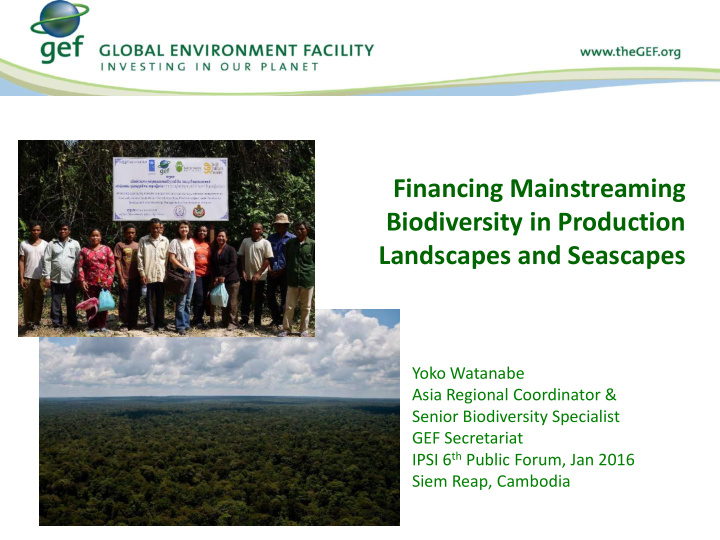



Financing Mainstreaming Biodiversity in Production Landscapes and Seascapes Yoko Watanabe Asia Regional Coordinator & Senior Biodiversity Specialist GEF Secretariat IPSI 6 th Public Forum, Jan 2016 Siem Reap, Cambodia
What is the GEF GEF is the largest public funder of projects to improve the global environment. Financial mechanism for the CBD, UNFCCC, UNCCD, POPs, and other international environmental agreements. Since 1991, GEF provided total $14 billion towards over 4000 projects to support developing countries and economies in 165 countries. GEF’s Six Focal Areas: Biodiversity, Climate Change, Int’l Waters, Ozone depletion, Land degradation, and POPs . Increased focus on integration.
Drivers and Integrated Approach: Mainstreaming Biodiversity in SEPLS • More than 70% of biodiversity is in landscapes and seascapes, beyond protected areas. • Major drivers and threats to biodiversity: agriculture, forestry, mining, and other sectors. • Need to work with multi-sectors, including public and private sectors for conservation and sustainable use of biodiversity.
SEPLS - Relation to the GEF-6 Strategies BD 3: Sustainable Use of Biodiversity Program 6: Ridge to Reef – Maintaining global significant coral reef ecosystem Program 7: Securing Agriculture’s Future – Sustainable Use of Plant and Animal Genetic Resources BD 4: Mainstream Biodiversity Conservation and Sustainable Use in Production Landscapes, Seascapes, and Sectors Program 9: Managing the human- biodiversity Interface - Landscape and seascape management Program 10: Integration of Biodiversity and Ecosystem Services into Development and Finance Planning.
Program 9: Managing the human-biodiversity interface • Develop policy and regulatory frameworks (e.g. agriculture, fisheries, forestry, etc) for biodiversity friendly land and resource use. • Conduct spatial and land use planning • Improve and change production practices (e.g. agriculture, forestry, fisheries, tourism, etc) • Development of financial mechanism (e.g. PES, certification, etc) to incentivize actors to change current practices.
Other Related GEF Strategies: Sustainable Land Management 1. Agro-ecological Intensification 2. SLM in Climate-Smart Agriculture 3. Landscape Management and Restoration 4. Scaling-up SLM 5. Mainstreaming SLM in Development Sustainable Forest Management 1. Maintain forest resources 2. Enhance forest management 3. Restore forest ecosystems 4. Increase regional and global cooperation
GEF Experience and Projects related to Mainstreaming Biodiversity Investment: Type of Projects: Policy and legislative FY2004-2014 frameworks; - 327 projects, Planning tools and regulations; - GEF $1.6 billion Production practices in key - Cofinance $5.2 billion sectors; Financial mechanism (PES, - More than 100 valuation, etc) countries • 251 projects focused on Production (on the ground, shifting production system etc) • 169 projects focused on Planning (land use planning/mgmt, etc)
Type and Geographic Regions
Mainstreaming Projects by Sector
SEPLS related Projects: Example (1) Cambodia: CAMPUS Project Strengthening landscape-based mgmt. of Cambodia’s Protected Areas System in the Eastern Nortern Plain (GEF grant $4.7m, Cofinance 14.5m, BD, CC, SFM) Improving: 1) Inter-sectoral governance (e.g. MoE and MAFF) 2) Landscape connectivity 3) Sustainable forest mgmt
SEPLS related Projects: Example (2) Global: GEF-Satoyama Project • Project Title: Mainstreaming biodiversity conservation and sustainable management in priority Socio-ecological Production Landscapes and Seascapes • Project finance: GEF Grant: $2 million, Cofinancing $6.35 million • Project Implementing partners: Conservation International, IGES, UNU-IAS, and others
Knowledge Generation: Determinants for Successful Mainstreaming Project 1. Project design based on theory of change. 2. Biophysical and socio-economic spatial information systems 3. Flexible project duration, financial sustainability and adaptive management 4. Effective project monitoring and evaluation 5. Alignment of with CBD and other processes 6. Alignment with government priorities, working across multiple sectors 7. Democratic, transparent and stable governance 8. Strong capacity at individual and institutional levels 9. Strong and responsive teams led by champions 10. Effective communication with stakeholders 11. Positive and continuous behavioral change
Thank you
Recommend
More recommend